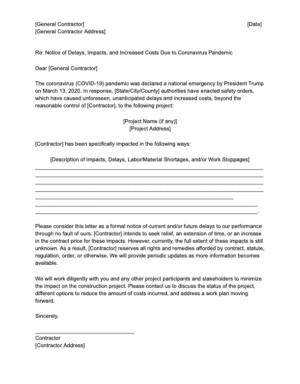
As the country continues to struggle with the coronavirus pandemic, construction companies are struggling to deal with the challenges COVID-19 presents. Many industry professionals have been warning of potential delays, disruptions, impacts, and more on construction projects for the foreseeable future. There are a number of different things construction professionals can do to protect their businesses. But with most project challenges, it all starts with sending a notice.
Subcontractor notice of COVID-19 related impacts and delays
Why you should send a COVID-19 notice
Being proactive is the best way to protect yourself on a construction project. If you are experiencing any delays, labor shortages, supply chain disruptions, or other impacts that are affecting your performance under the contract, it may be time to send notice to the GC. Subcontractors should look to the terms of their contract to determine if and when notices are required when experiencing problems on the job site.
Providing a formal notice will not only reserve your contractual rights but also helps to increase communication and promote transparency on the project. Furthermore, courts tend to enforce contractual notice requirements strictly so be sure to follow the procedure closely.
What a COVID-19 notice should contain
Now let’s get into the actual notice itself.
- The notice should describe the impacts on the project, along with language that indicates the impacts were unforeseeable, unanticipated, and beyond your control.
- Detail how these impacts have affected your schedule or costs.
- If there is a relevant delay or force majeure clause in your contract, make sure to cite that section.
- Lastly, include the type of relief that you are seeking (time extension, contract price increase, etc) and state that you reserve all rights and remedies afforded to you under the contract, law, or otherwise.
As stated above, be sure to familiarize yourself with the notice requirements in the contract. It should indicate the timeframe in which a notice should be sent and the method of delivery. Typically, construction contracts will require you to send notices by certified mail. If so, make sure it’s sent in that manner.
In addition to mailing the notice, it may be a good idea to send an email containing the same information and referencing the notice sent by mail. That way, the mailed notice is effective and the GC gets the information as quickly as possible.
The GC received the notice. Now what?
If you are a general contractor, and you’ve received a COVID-19 notice from a subcontractor, what’s next? Well, at the very least, the GC should confirm that they’ve received the notice and consult with the property owner. Then it’s time to sit down and review the subcontract and the subcontractor default insurance policies (if any) to determine the best course of action. Depending on the terms of the contract, there are three likely scenarios here.
1. Grant relief
This is the best-case scenario for subcontractors. The determination of whether the delay entitles the sub to any remedies depends on the terms of the contract and is rather extensive. The GC will take the project schedule’s critical path and other factors to determine whether the impacts or delays are excusable and compensable under the delays clause, force majeure clause, escalation clause, or any other relevant provisions of the contract.
If so, the GC may grant the sub an extension for performance time, an increase in the contract performance, and/or additional compensation for material price escalations.
- For further reading: Does Your Force Majeure Clause Cover Coronavirus-Related Delays?
2. Supplement the subcontractor’s labor
If allowed under the contract, the GC may opt to supplement the subcontractor’s work. This could mean supplying additional laborers or reducing their scope of work. For example, limiting their contract through a deductive change order or partial termination. to labor only, and take over the provision of labor or materials on their own.
Subcontractors should keep in mind that, if this is the route the GC decides, they will most likely be backcharged, or the contract price will be reduced.
3. Terminate and replace the subcontractor
If the delay isn’t an excusable one under the terms of the contract, and the non-performance results in a breach of contract, the GC may decide to invoke the termination clause. Specifically, a termination for cause. This will usually involve a notice, an opportunity to cure or remedy the problem. If that fails, they may send a final notice directing the sub to demobilize and leave the job site.
The general contractor should take care to follow all of the notice and timing provisions in their termination clause. Failing to follow all requirements may lead to an improper termination.



